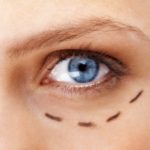Perhaps the most well-known procedure in cosmetic surgery is the classic face lift, which also happens to be one of the oldest and most commonly performed. Technically, the procedure is referred to as Rhytidectomy, which is aptly translated as “the surgery to remove wrinkles”. The goal of any face lift is to improve the structure and appearance of the patient’s face, both by correcting any damage or irregularities, and by eliminating wrinkles, loose skin, and other signs of advancing age. Individual procedures will vary slightly due to unique facial shapes and patient goals, but the essential operation is always the same. Cosmetic eyelid surgeries are now often performed in addition to the traditional face lift, as part of a larger aesthetic plan.
The Face Lift
The face lift surgery itself involves the stretching, smoothing and reattachment of the patient’s skin in order to remove excess folds or soft tissue. While the patient is sedated, small incisions are made above and behind the ears, which allows the skin around the cheek and the neck to be gently separated and pulled back. In many cases, cosmetic surgeons will use sutures to tighten underlying facial muscle at this point, although this is not always necessary. Next, the skin is re-stretched to the desired tightness, eliminating any folds. Once the surgeon has identified and removed any excesses, the skin can be realigned and sutured.
Though the face lift process is fairly simple (from a medical point of view), it involves some very sensitive tissues, which means some amount swelling and bruising will occur. It is important to follow any post-procedural instructions your surgeon may give you, and to allow proper recovery time for your sutures to fully heal.
Cosmetic Eyelid Surgery
 Cosmetic surgery of the eyelid is a comparatively new technique that has already become extremely popular. The procedure, known as blepharoplasty, targets extraneous skin and fatty tissue around the eyelid for adjustment or removal, and can also include a surgical tightening of the surrounding muscle and tendons. The goal of blepharoplasty is typically the elimination of any unwanted bagging or folding of the skin around the eye, along with the elimination and prevention of wrinkles. Despite being a purely elective procedure, blepharoplasty can have functional benefits along with the cosmetic, having been shown to restore peripheral vision deficits caused by excessive puffiness or displaced skin in many cases.
Cosmetic surgery of the eyelid is a comparatively new technique that has already become extremely popular. The procedure, known as blepharoplasty, targets extraneous skin and fatty tissue around the eyelid for adjustment or removal, and can also include a surgical tightening of the surrounding muscle and tendons. The goal of blepharoplasty is typically the elimination of any unwanted bagging or folding of the skin around the eye, along with the elimination and prevention of wrinkles. Despite being a purely elective procedure, blepharoplasty can have functional benefits along with the cosmetic, having been shown to restore peripheral vision deficits caused by excessive puffiness or displaced skin in many cases.
The typical blepharoplasty can last up to three hours, and begins with a small incision into the eyelid, typically made along a natural skin crease or line, in order to help conceal any resultant scarring. After his incisions have been made, the cosmetic surgeon can extract the targeted fat deposits. Once this process is completed, any excess skin tissue can be removed. In addition to this procedure, many cosmetic surgeons also offer a transconjunctival blepharoplasty, which uses an interior incision on the lower eyelid. While this specialized variety of eyelid surgery does virtually eliminate any concern of visible scarring, it only addresses the lower eyelid and does not allow for skin removal, making it a limited, if very appealing, option.
It is important to remember that both a face lift and blepharoplasty are serious surgical procedures, and you should carefully weigh any risks with your doctor before making a decision. Non-surgical options are also available for facial treatments – call 1-800-IDEAL-YOU to connect with a top cosmetic surgeon in your area and start your consultation today!

